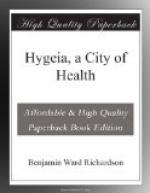The streets of the city are paved throughout with the same material. As yet wood pavement set in asphalte has been found the best. It is noiseless, cleanly, and durable. Tramways are nowhere permitted, the system of underground railways being found amply sufficient for all purposes. The side pavements, which are everywhere ten feet wide, are of white or light grey stone. They have a slight incline towards the streets, and the streets have an incline from their centres towards the margins of the pavements.
From the circumstance that the houses of our model city are based on subways, there is no difficulty whatever in cleansing the streets, no more difficulty than is experienced in Paris. That disgrace to our modern civilisation, the mud cart, is not known, and even the necessity for Mr. E.H. Bayley’s roadway moveable tanks for mud sweepings,—so much wanted in London and other towns similarly built,—does not exist. The accumulation of mud and dirt in the streets is washed away every day through side openings into the subways, and is conveyed, with the sewage, to a destination apart from the city. Thus the streets everywhere are dry and clean, free alike of holes and open drains. Gutter children are an impossibility in a place where there are no gutters for their innocent delectation. Instead of the gutter, the poorest child has the garden; for the foul sight and smell of unwholesome garbage, he has flowers and green sward.
It will be seen, from what has been already told, that in this our model city there are no underground cellars, kitchens, or other caves, which, worse than those ancient British caves that Nottingham still can show the antiquarian as the once fastnesses of her savage children, are even now the loathsome residences of many millions of our domestic and industrial classes. There is not permitted to be one room underground. The living part of every house begins on the level of the street. The houses are built of a brick which has the following sanitary advantages:—It is glazed, and quite impermeable to water, so that during wet seasons the walls of the houses are not saturated with tons of water, as is the case with so many of our present residences. The bricks are perforated transversely, and at the end of each there is a wedge opening, into which no mortar is inserted, and by which all the openings are allowed to communicate with each other. The walls are




